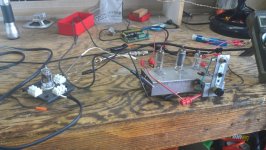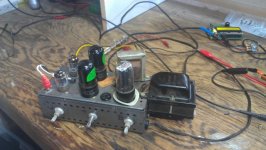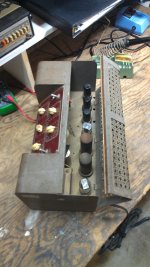I've learned so much playing with non-guitar tube stuff, which is great for me because I've only been doing this a couple years now. I would first notice the similarities to standard Fender/Marshall circuits, but it's been the differences that have taught me things. Like a tube intercom that (to optimize voice) had a cap across the OT (bass-cut), and a 0.005u coupling cap in the preamp (hi-cut). Then there was a Webcor phonograph (coolest little P-P 6v6 amp!), with the weirdest tone stack....turned out to be the RIAA restoration circuitry. I've also got a Manatt-King p-p 6L6 PA that I looked at a year ago, but shelved it because it was too wierd.... it works, but why/how? Plan on digging it back out and trying to figure out all the idiosynchracies it it....
Does anybody else have something like this to share, to help all us newbies? I've learned some much from you guys! Thanks
Does anybody else have something like this to share, to help all us newbies? I've learned some much from you guys! Thanks
Attachments
Old tubed 6V or 12V car radios are cool. Many have 6V6 or 12V6 output tubes. Check before you tear one apart, some are worth big bucks if you can get it working and find a buyer. There is a guy that I see at guitar shows that takes whatever he can find and converts it to a guitar amp.
Yeah, I bet someone restoring an old car would love to have a working authentic radio in it! I've heard about low-voltage tube designs using a "space charge" principle to allow them to work with very low plate voltages (somehow using the first grid to accelerate electrons to the plate). Amazing innovations from the past! I tore into the old intercom because I just couldn't believe anyone would use one, although I did document the original schematic....
I hope you will find the following articles useful:
Converting Integrated/PA Tube Amps into Guitar Amps
Notes on Converting PA Amps to Guitar Amps
Converting Integrated/PA Tube Amps into Guitar Amps
Notes on Converting PA Amps to Guitar Amps
Thanks jazbo! I've seen the first link (have it in my 3-ring "library"), but the 2nd is great! Especially "mu.com", on tube specs and comparisons. Thanks! I feel like a 2yo kid...every time I see something I don't understand, I ask "why"...then "why" again...! I don't mind reinventing the wheel, it's the journey. At my age, being still able to learn is precious!
I've been doing this for years. PA amps are easy. They are pretty much already guitar amps. Most have those funky screw on input connectors which you need to replace with standard 1/4" phone jacks. The tone controls are generally perfect for guitar work. Usually Baxandall type and not the types of tone controls referred to as 'tone stacks' or Marshall Vox Fender type tone control circuits. Hifi amps are of the type where they either have only a line level type gain stage ( units out of consoles with Xtal phono inputs) or the type with a true RIAA phono stage ( more expensive amps like the Scott 99D). A cheap quick trick to enable the use of the RIAA phono input is to solder a 150 pf capacitor between the phono input jack and it's circuitry in the amp. This effectively negates the RIAA equalization yet retains the gain of the phono stage, which you will need to properly amplify a guitar signal. You can experiment with the value of this capacitor, but 150 pf has worked for me in the past. RIAA networks are designed to heavily boost bass while cutting treble. This capacitor heavily cuts bass while retaining the high frequencies. Like I said, it is a quick and dirty fix for the RIAA eq in a vintage tube hifi amp's phono stage, which is the only stage with enough gain for guitar use.
seta1-thanks for the tips! I usually adapt those old "UHF" button connectors with a cut-down male connector - use them on my old radio RF signal generators. My PA has 3 input channels, all octal 12SJ7s. Want to find a dual triode 8-pin and rewire them to get another gain stage for guitar use. Need to look at Baxandall tone circuits, how they differ from the usual tone stacks.....been playing with tremelo circuits, both tube and SS. I hear the Magnatone actually had a true "vibrato" - wonder how they did that.
The 12SJ7's actually have a lot of gain on tap and can sound very good if you choose the right circuit values, but the octal 12ax7 "equivalent" would be a 6sc7 but they have no lower gain subs with the same pinout and they have common cathodes I believe so limited circuits are possible.
The 12SJ7's actually have a lot of gain on tap and can sound very good if you choose the right circuit values, but the octal 12ax7 "equivalent" would be a 6sc7 but they have no lower gain subs with the same pinout and they have common cathodes I believe so limited circuits are possible.
I'm a big fan of 6/12 SJ7's too, have used them in several amps, most recently a Gibson GA-9 clone built with a 12SJ7 and two 12V6's in parallel SE, best sound of anything I've built yet and about 9 watts FWIW...sort of a 5C1/Les Paul Jr. with an extra tube.
The 6SL7 is sometimes used as an octal equivalent of a 12AX7 and does have seperate cathodes...but hum can be a problem from what I've experienced and have read (though it can be sorted out) The 6SC7 and 6SJ7 usually have metal cans and this can help with hum control...but the 6SC7 has common cathodes as was said so that limits its usefulness.
Tube amp design can be a bit of a black art.
Layout, decoupling and heater circuit design all need to be correct to get a noise/hum free design.
On my early designs I didn't elevate the heaters to 40VDC.
I also had long paths on pcb's which picked up interference.
I didn't decouple each valve stage separately.
I even placed mains transformer near the valves !
Layout, decoupling and heater circuit design all need to be correct to get a noise/hum free design.
On my early designs I didn't elevate the heaters to 40VDC.
I also had long paths on pcb's which picked up interference.
I didn't decouple each valve stage separately.
I even placed mains transformer near the valves !
Billc99 - what did you use for an OPT for the parallel SE 12V6's?
I'm looking for a 2.5k:3-4 ohm SE transformer with 70 mADC rating..for a GA-9
Thanks
Murray
I used a Hammond 125E I had on hand, Hammond used to market these as suitable for SE or PP use, it sounds pretty good to me in my GA9 clone...but if I needed to buy another SE transformer I'd try one from Edcor, low $$$ and they work well from what I've read.
https://www.edcorusa.com/singleended
I was looking at the Hammond 125-series...a little confusing as they seem to have some that work in single-ended circuits, and some that are made for SE...bigger, a little more expensive, etc.
Like 125DSE...has the 70 mADC rating I want...I suppose you lose inductance if you use a lower-DC-current-rated one.
Thanks
Like 125DSE...has the 70 mADC rating I want...I suppose you lose inductance if you use a lower-DC-current-rated one.
Thanks
Hello, LATubeGeek, I hope you are checking this forum and this old thread, too. I recently acquired a PA amplifier nearly identical to your Manett-King in the photo above. Mine is in need of a restoration, all the iron and original components are present, but two of the tubes are missing, the phase inverter and the rectifier. Mine has all three 12SJ7 preamps and the two 6L6 power tubes, but I'm wondering if you still have yours and what the tube compliment might be? I suspect that the rectifier is either a 5U4 or perhaps a 5Y3. The phase inverter tube socket is wired for either a 6SL7 or 6SN7, as far as I can deduce. Any help or information would be greatly appreciated. Happy New Year, hope you see this sometime soon.  SFLC
SFLC
You may have realised there are some 'common' circuit styles used for many guitar amps, especially the 1M input loading, and the input levels typically aimed for, and whether feedback is an advantage or not for different guitar speaker setups. Many who play guitar will adjust the tone and overload characteristics to their own liking for the particular guitar and speaker box they use, which may be just ubiquitous setups found in certain Fender etc circuits that have since been re-issued and cloned by many. Do you play guitar and want to go that path to tweaking a PA amp?
If you don't go that path then I'd suggest you try and implement a soundcard and software based bench tool that allows you to do rapid frequency sweeps for tone control and stage frequency responses as a way to set up stage coupling and tone control circuitry values. It also helps you visualise how well the frequency response is being rolled off at the limits of guitar related frequencies, as there are more likely to be other hassles if your amp has full power response down to 20Hz and up to 20kHz.
That tool also allows you to view the rise of distortion components with signal level and how each stage may contribute to overall distortion and over-drive response. That can allow you to appreciate the use of stoppers, and how part values contribute to blocking distortion, and how different types of circuit operate when overloaded.
That tool also allows you to view if there are any parasitic resonances blooming out of the noise floor due to wiring and layout issues, and allows you to identify hum sources if they become objectionable through a test speaker.
If you don't go that path then I'd suggest you try and implement a soundcard and software based bench tool that allows you to do rapid frequency sweeps for tone control and stage frequency responses as a way to set up stage coupling and tone control circuitry values. It also helps you visualise how well the frequency response is being rolled off at the limits of guitar related frequencies, as there are more likely to be other hassles if your amp has full power response down to 20Hz and up to 20kHz.
That tool also allows you to view the rise of distortion components with signal level and how each stage may contribute to overall distortion and over-drive response. That can allow you to appreciate the use of stoppers, and how part values contribute to blocking distortion, and how different types of circuit operate when overloaded.
That tool also allows you to view if there are any parasitic resonances blooming out of the noise floor due to wiring and layout issues, and allows you to identify hum sources if they become objectionable through a test speaker.
Thanks for the tips. I'm really enjoying restoring the old PA amps back to spec first, rarely do I change any of the component values, just as a starting point. I like to get the units up and running the way they were originally designed and getting a listen to them as they were. As a player, I am delighted by the differences in tone and response, not really working with any kind of magical or scientific formulae. Yet.You may have realised there are some 'common' circuit styles used for many guitar amps, especially the 1M input loading, and the input levels typically aimed for, and whether feedback is an advantage or not for different guitar speaker setups. Many who play guitar will adjust the tone and overload characteristics to their own liking for the particular guitar and speaker box they use, which may be just ubiquitous setups found in certain Fender etc circuits that have since been re-issued and cloned by many. Do you play guitar and want to go that path to tweaking a PA amp?
If you don't go that path then I'd suggest you try and implement a soundcard and software based bench tool that allows you to do rapid frequency sweeps for tone control and stage frequency responses as a way to set up stage coupling and tone control circuitry values. It also helps you visualise how well the frequency response is being rolled off at the limits of guitar related frequencies, as there are more likely to be other hassles if your amp has full power response down to 20Hz and up to 20kHz.
That tool also allows you to view the rise of distortion components with signal level and how each stage may contribute to overall distortion and over-drive response. That can allow you to appreciate the use of stoppers, and how part values contribute to blocking distortion, and how different types of circuit operate when overloaded.
That tool also allows you to view if there are any parasitic resonances blooming out of the noise floor due to wiring and layout issues, and allows you to identify hum sources if they become objectionable through a test speaker.
SFLarry, that is a great approach imho, especially if the PA amp is not too old and allows the majority of parts and wiring to remain as is. Restoration is a great way to start and enjoy the learning curve of valve amp operation. Every PA amp I've restored has been different and brought up interesting aspects.
Although it's based on Australian examples, the linked article covers many aspects of PA amp restoration (https://www.dalmura.com.au/static/Renovating PA amps.pdf).
Although it's based on Australian examples, the linked article covers many aspects of PA amp restoration (https://www.dalmura.com.au/static/Renovating PA amps.pdf).
- Home
- Live Sound
- Instruments and Amps
- Turning old tube stuff into guitar amps


